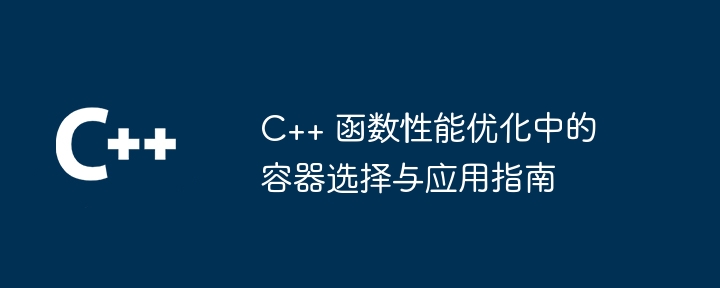Home >Backend Development >C++ >Guide to container selection and application in C++ function performance optimization
Guide to container selection and application in C++ function performance optimization
- PHPzOriginal
- 2024-04-24 09:27:01375browse

#Container Selection and Application Guide in C Function Performance Optimization
Containers are the basic tools in C for storing and managing data structures. In function optimization, choosing the right container is crucial to improving performance. This article will provide a container selection guide to help you choose the most appropriate container for your specific needs.
Common container types
- Array: The container with the best performance, but the size is fixed and cannot be modified dynamically.
- Vector: Dynamic array, the capacity can be adjusted automatically. Inserting and deleting elements is relatively efficient.
- Linked list: Linear data structure, insertion and deletion operations are efficient, but random access performance is poor.
- Hash table: Container based on key-value pairs, the search operation efficiency is very high.
- Set: Container that does not contain duplicate elements, search and insertion operations are more efficient.
- Mapping: Container of key-value pairs, similar to a hash table, but keeping the keys sorted.
Container Selection Guide
| Scenario | Recommended Container | Reason |
|---|---|---|
| Need fast random access | Array | Fixed size, optimal performance |
| Requires dynamic adjustment of capacity | Vector | Flexible adjustment of size, better performance |
| Needs efficient insertion and deletion | Linked list | Optimization for these operations |
| Requires efficient search | Hash table | Based on key-value pairs, search is extremely fast |
| Need not to contain duplicate elements | Collection | Fast search and insertion, no duplicates |
| Need to be based on Sorting of key-value pairs | Mapping | Combining the advantages of hash table and sorting |
Practical case
Find the maximum value in a string array
// 使用数组,O(n) 时间复杂度
int max_value(const string arr[], int size) {
int max = arr[0];
for (int i = 1; i < size; ++i) {
if (arr[i] > max) {
max = arr[i];
}
}
return max;
}
// 使用哈希表,O(1) 时间复杂度
int max_value(const string arr[], int size) {
unordered_map<string, int> values;
for (const string& s : arr) {
if (values.count(s) == 0) {
values[s] = 1;
} else {
values[s]++;
}
}
int max_count = 0;
string max_string;
for (const auto& [str, count] : values) {
if (count > max_count) {
max_count = count;
max_string = str;
}
}
return max_string;
}In this case, using a hash table can significantly optimize the search performance, because its search operation is O( 1) Time complexity, and the search operation of the array is O(n) time complexity.
The above is the detailed content of Guide to container selection and application in C++ function performance optimization. For more information, please follow other related articles on the PHP Chinese website!

